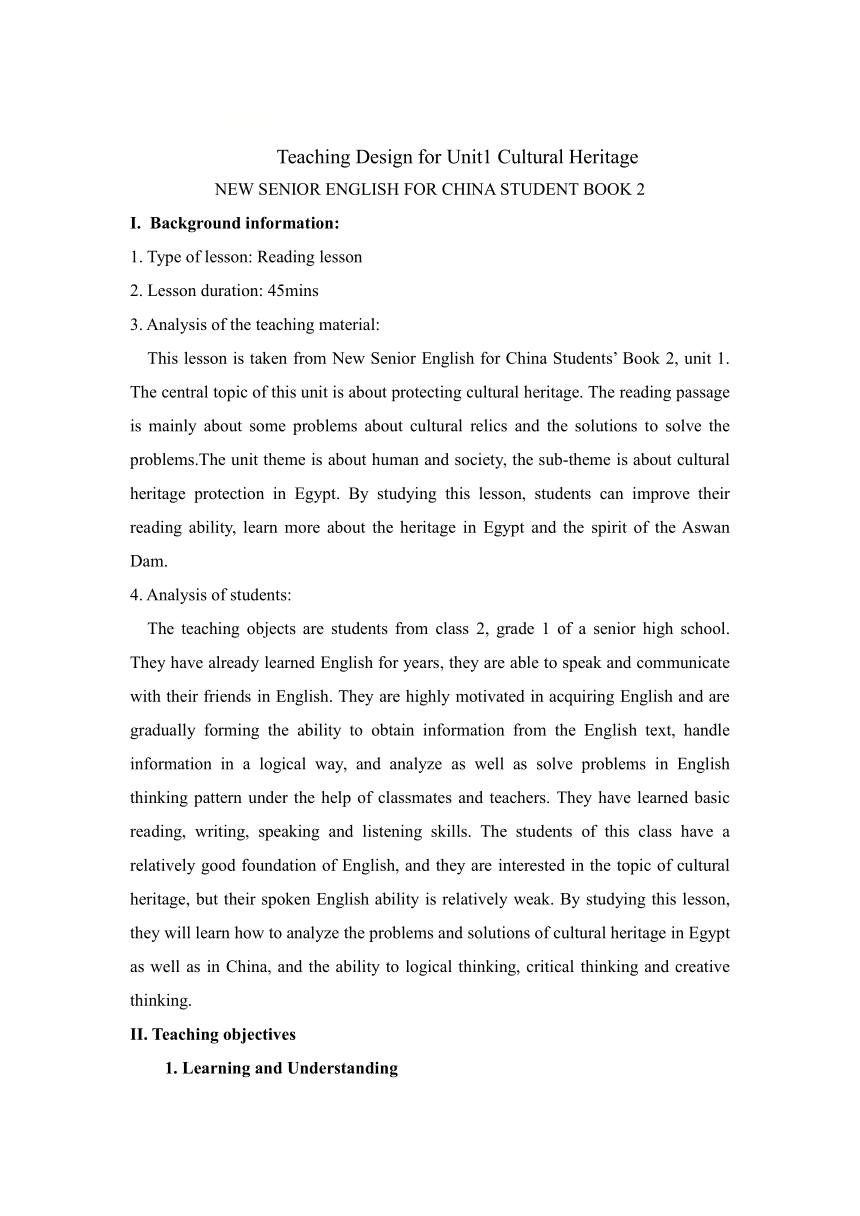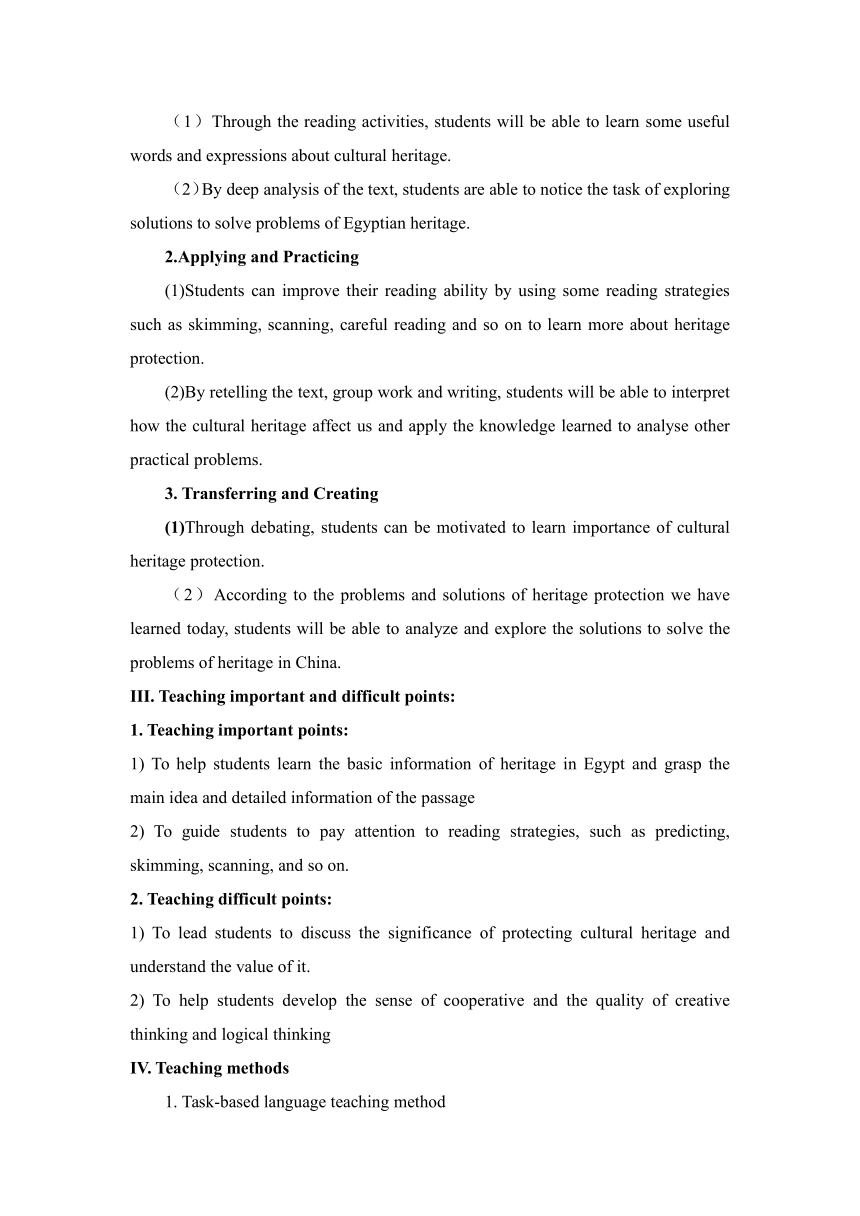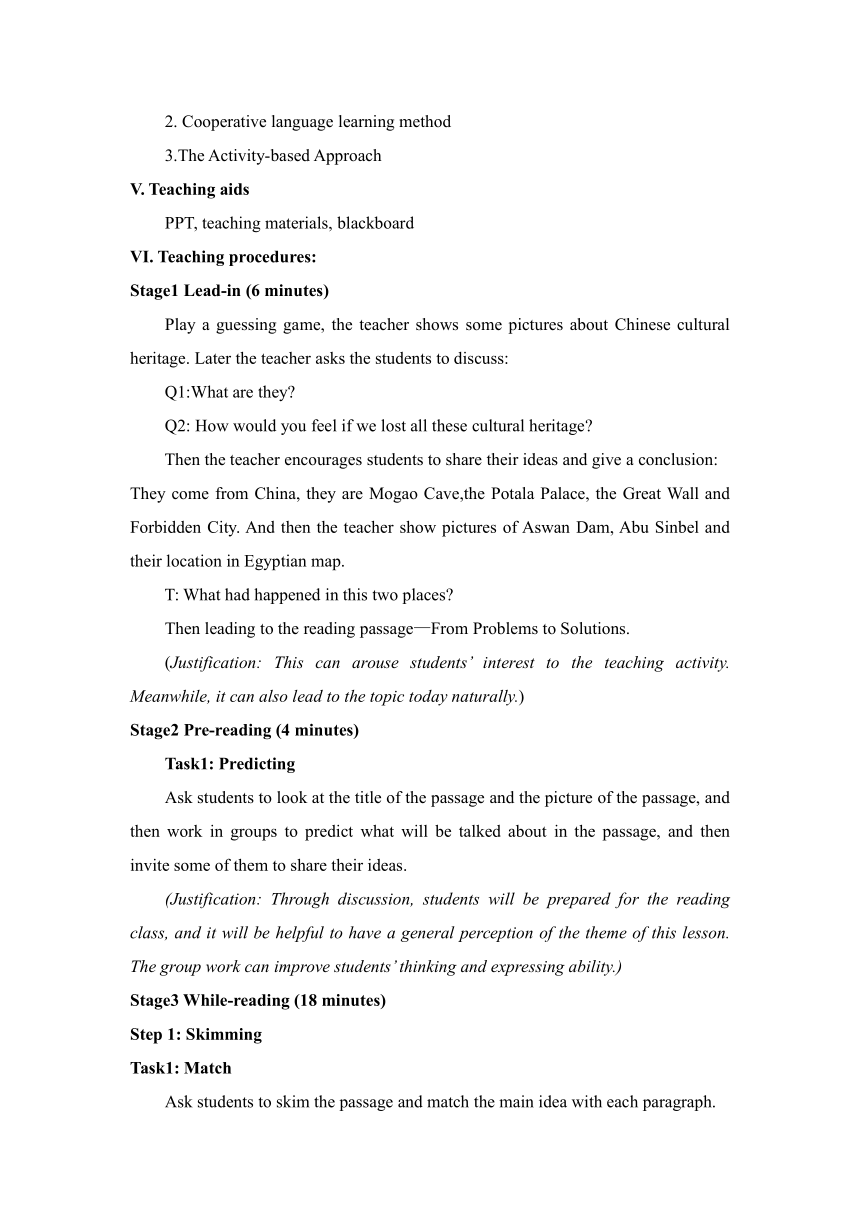 资源简介
资源简介
Teaching Design for Unit1 Cultural Heritage
NEW SENIOR ENGLISH FOR CHINA STUDENT BOOK 2
Background information:
1. Type of lesson: Reading lesson
2. Lesson duration: 45mins
3. Analysis of the teaching material:
This lesson is taken from New Senior English for China Students’ Book 2, unit 1. The central topic of this unit is about protecting cultural heritage. The reading passage is mainly about some problems about cultural relics and the solutions to solve the problems.The unit theme is about human and society, the sub-theme is about cultural heritage protection in Egypt. By studying this lesson, students can improve their reading ability, learn more about the heritage in Egypt and the spirit of the Aswan Dam.
4. Analysis of students:
The teaching objects are students from class 2, grade 1 of a senior high school. They have already learned English for years, they are able to speak and communicate with their friends in English. They are highly motivated in acquiring English and are gradually forming the ability to obtain information from the English text, handle information in a logical way, and analyze as well as solve problems in English thinking pattern under the help of classmates and teachers. They have learned basic reading, writing, speaking and listening skills. The students of this class have a relatively good foundation of English, and they are interested in the topic of cultural heritage, but their spoken English ability is relatively weak. By studying this lesson, they will learn how to analyze the problems and solutions of cultural heritage in Egypt as well as in China, and the ability to logical thinking, critical thinking and creative thinking.
II. Teaching objectives
1. Learning and Understanding
(1)Through the reading activities, students will be able to learn some useful words and expressions about cultural heritage.
(2)By deep analysis of the text, students are able to notice the task of exploring solutions to solve problems of Egyptian heritage.
2.Applying and Practicing
(1)Students can improve their reading ability by using some reading strategies such as skimming, scanning, careful reading and so on to learn more about heritage protection.
(2)By retelling the text, group work and writing, students will be able to interpret how the cultural heritage affect us and apply the knowledge learned to analyse other practical problems.
3. Transferring and Creating
(1)Through debating, students can be motivated to learn importance of cultural heritage protection.
(2)According to the problems and solutions of heritage protection we have learned today, students will be able to analyze and explore the solutions to solve the problems of heritage in China.
III. Teaching important and difficult points:
1. Teaching important points:
1) To help students learn the basic information of heritage in Egypt and grasp the main idea and detailed information of the passage
2) To guide students to pay attention to reading strategies, such as predicting, skimming, scanning, and so on.
2. Teaching difficult points:
1) To lead students to discuss the significance of protecting cultural heritage and understand the value of it.
2) To help students develop the sense of cooperative and the quality of creative thinking and logical thinking
IV. Teaching methods
1. Task-based language teaching method
2. Cooperative language learning method
3.The Activity-based Approach
V. Teaching aids
PPT, teaching materials, blackboard
VI. Teaching procedures:
Stage1 Lead-in (6 minutes)
Play a guessing game, the teacher shows some pictures about Chinese cultural heritage. Later the teacher asks the students to discuss:
Q1:What are they
Q2: How would you feel if we lost all these cultural heritage
Then the teacher encourages students to share their ideas and give a conclusion:
They come from China, they are Mogao Cave,the Potala Palace, the Great Wall and Forbidden City. And then the teacher show pictures of Aswan Dam, Abu Sinbel and their location in Egyptian map.
T: What had happened in this two places
Then leading to the reading passage—From Problems to Solutions.
(Justification: This can arouse students’ interest to the teaching activity. Meanwhile, it can also lead to the topic today naturally.)
Stage2 Pre-reading (4 minutes)
Task1: Predicting
Ask students to look at the title of the passage and the picture of the passage, and then work in groups to predict what will be talked about in the passage, and then invite some of them to share their ideas.
(Justification: Through discussion, students will be prepared for the reading class, and it will be helpful to have a general perception of the theme of this lesson. The group work can improve students’ thinking and expressing ability.)
Stage3 While-reading (18 minutes)
Step 1: Skimming
Task1: Match
Ask students to skim the passage and match the main idea with each paragraph.
Para.1 Spirit
Para.2 Committee established
Para.3 Success
Para.4 Challenge
Para.5 Proposal
Para.6 Being brought together
Task2: Read for Structure
Ask students to summarize the structure of the passage.
part 1 (Para.1-2) ------Problems
part 2 (Para.3-4) ------Solutions
part 3 (Para.5-6)-------Results
Step 2: Careful reading
Ask students to locate certain information by reading the passage quickly to finish the following task:
Task1 : Read Part 1 for details
Activity 1:Answer the Questions
Q1: What’s the problem mentioned in para.1
Q2: What’s the problem mentioned in para.2
Q3: Why did the Egyptian government want to build a new dam
Q4: What’s the relationship between two problems
Activity 2: Free Talk
After students have learned about what the problems are, the teacher ask student a question.
T: Do you think it is easy to solve the problem Why
S1:I think it’s not easy to solve the problem, because the new dam and temples are both important to us. It’s so difficult to solve problems that not destroy temples.
T:Of course, it is so difficult to solve the problem. So, What did the Egyptian government decide to do to solve this problem
Ss:They turned to the UN for help in 1959.
(Justification: The teacher guides students to notice the numbers in the text step by step, which can help students understand how the problems solved .)
Task 2: Read Part 2 for details
Activity 1: Timeline
Ask students to complete the timeline and the table about how the UN deal with this problem of building Aswan Dam.
Activity 2: Watch a video
Ask students to watch a video about how the culture relics saved, and summarize the steps.
Activity 3:Scanning
Ask students to scan this part for other numbers, and circle the numbers and guess what they mean.
Task 3: Read Part 3 for details
Activity 1:Thinking
Ask students to think that why the project is regarded as a great success, who made the success possible and what’s the spirit of the Aswan Dam.
(Justification: Fast reading can help students grasp the main idea and specific information of the passage. Careful reading can deepen students’ understanding of the passage and improve their reading ability.)
Stage 4: Post-reading(10 minutes)
Task1: Debating
T:Is it worthwhile to spend so much time and money in protecting these cultural relics Why or why not
Ask students to debate with the topic that whether it is worthwhile to spend so much time and money in protecting these cultural relics or not.
Task 2: Group discussion
Introduce the work of restoring Dunhuang Mural and finish the table about the structure we have learned today. Then ask students to think about what they can do to protect cultural relics and ask them to show their ideas.
(Justification: This can help students have deeper learning about the significance of cultural heritage protection, and train students’ sense of cooperation and communicative competence.Let students know that we can also do something to protect cultural heritage though they are just a student.)
Stage5: Summary&Homework (3 minutes)
Step1: Summary
Ask students to make a mind map about the passage, then ask one student to show his mind map and retell the passage according to its basic structure.
(Justification: The mind-map can help students review the whole passage. Reviewing the important knowledge can deepen students’ impression and form good study habits.)
Step2: Homework
1.Required: Write a passage about protecting the Dunhuang Mural by using what you have learned in this lesson.
2.Optional: Make a poster calling on people to protect cultural relics.
(Justification: This activity can develop students’ critical thinking and expressing ability and alternative homework can stimulate students’ learning interest and help them develop individually.)
VII. Blackboard design
VIII. Teaching reflection
Highlights: Group discussion on the solutions and alternative homework stress the development of students' creative thinking.
Improvements:However, due to limited time, students may not have enough opportunities to engage in discussion and share their works. Additionally, improvements are needed in the content and manner of teacher evaluation.
展开更多......
收起↑
 资源预览
资源预览



 资源预览
资源预览


